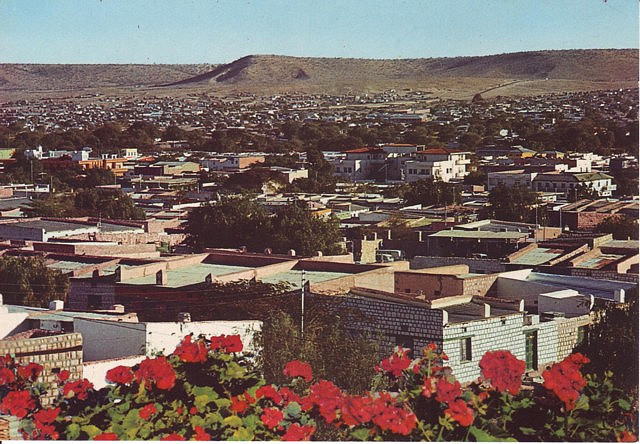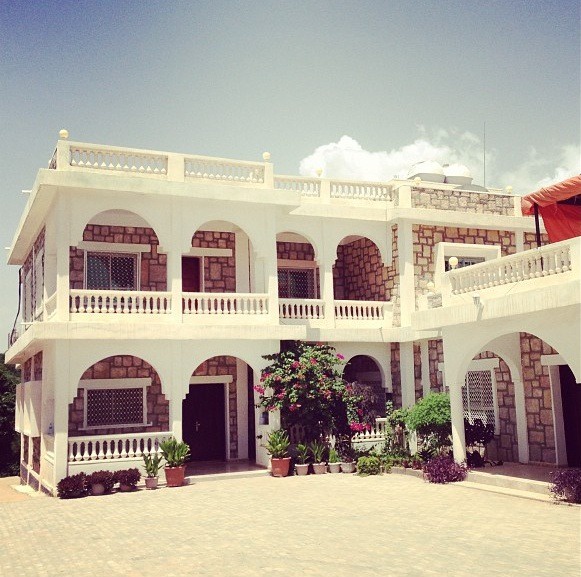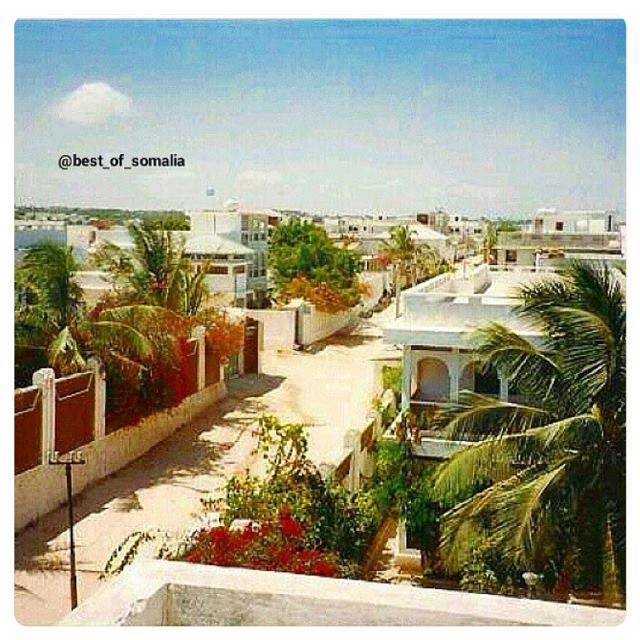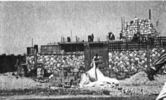Hello everyone. I was wondering if anyone had any knowledge of how Somali homes used to look like. I’m talking pre-colonialism. Specifically what kinda floors they had, (was it tiled and if so, what kind of designs), if they had beds or sofas, or maybe just mattresses? What kind of decor and objects they may have had? Any information on how our houses may have looked, outside and inside, would be appreciated. Thank you
You are using an out of date browser. It may not display this or other websites correctly.
You should upgrade or use an alternative browser.
You should upgrade or use an alternative browser.
HISTORY Ancient Somali Homes
- Thread starter khadrasufi
- Start date
Somali houses were multi storied buildings white washed with coral and adorned with courtyards, large bath and many windows.
Somalis love nature trees, greenery and open spaces, so historically many of the town lay outs and houses featured courtyards and people would plant trees and gardens. Any visitor that came to our major commercial centers would note this
Description of the city build out of Berbera in the 1800s:

Same thing was observed in Zayla, Mogadishu, Harar Luuq etc. In Benadiir i read that they would employ people from the country side with special expertise in planting trees which they called ''BaarFuul''(Palm Trees Cultivators).
With that said you can't underestimate a functional state or government, when a commercial city grew wealthy and was governed by an Emir or a Governor in the past it usually involved some level of planning. Further more during the Kacaan government they sought to continue the Somali cultural architecture of white washed dwellings- with many washed villas surrounded with garden and streets were lined with palm trees.
It's what characteristically gave Mogadishu the name ''The white pearl of the the Indian ocean'' . So how cities looked were enhanced by a central coordinator.
The whitewashed dwellings and buildings is a typical cultural feature you would see throughout Somali society, even in the countryside away from the cities you would see it with old tombs dotted throughout.

In Somali culture the colour white symbolizes purity, virtue and truth.
Bright coloured buildings you see today are not really a cultural Somali thing, and if they added anything to the houses would usually be covered with wooden balconies , window/door carvings and roofs.
Idilinaa
VIP
Somali houses were multi storied buildings white washed with coral and adorned with courtyards, large bath and many windows.
Not all was multi storied, and only the very very rich classes at the top lived in buildings like that and had large courtyards. The rest of the less well off lived either in one storied white washed stone houses or carrishes which are wooden houses. This in the towns.
The richer a city or town became the more common place coral washed stones houses became and multi storied homes.
In that post of mine that you qouted i was mainly referring to how pre-colonial Somalis having a tendency to plant gardens and palm trees to beautify the areas that they lived in. And used Berbera as an example
How it looked like:

Berbera Native town from the costum pier

Last edited:
Do you have examples of other towns? I assume houses across Somaliweyn were of similar styleNot all was multi storied, and only the very very rich classes at the top lived in buildings like that and had large courtyards. The rest of the less well off lived either in one storied white washed stone houses or carrishes which are wooden houses. This in the towns.
The richer a city or town became the more common place coral washed stones houses became and multi storied homes.
In that post of mine that you qouted i was mainly referring to how pre-colonial Somalis having a tendency to plant gardens and palm trees to beautify the areas that they lived in. And used Berbera as an example
How it looked like:

Berbera Native town from the costum pier

Idilinaa
VIP
Do you have examples of other towns? I assume houses across Somaliweyn were of similar style
Other pictures of courtyards adorned with gardens and palm trees? No i mainly have descriptions by visitors at the moment
When Richard Burton for example visited Zeila, Sharmarka Ali Saleh house had a large courtyard , same when he visited the palace of the Harar Amir and Shaykh Jamai Al-Bartirii home at the center of the city, they were refered to as having courtyards.
The average home of Harar in particular was said to have gardens where the women cultivate it .
And in the southern coastal cities they would have people from the country side cultivate palm trees. For example Barawa was surounded by Palm trees, visitors would stop to look at it with awe
The Incredible Voyage: A Personal Odyssey

Last edited:
Idilinaa
VIP
Other pictures of courtyards adorned with gardens and palm trees? No i mainly have descriptions by visitors at the moment
When Richard Burton for example visited Zeila, Sharmarka Ali Saleh house had a large courtyard , same when he visited the palace of the Harar Amir and Shaykh Jamai Al-Bartirii home at the center of the city, they were refered to as having courtyards.
The average home of Harar in particular was said to have gardens where the women cultivate it .
And in the southern coastal cities they would have people from the country side cultivate palm trees. For example Barawa was surounded by Palm trees, visitors would stop to look at it with awe
The Incredible Voyage: A Personal Odyssey

Actually found an old photo of Mogadishu with houses surrounded by palm trees and greenery

Idilinaa
VIP
And in the southern coastal cities they would have people from the country side cultivate palm trees. For example Barawa was surounded by Palm trees, visitors would stop to look at it with awe
The Incredible Voyage: A Personal Odyssey

Barawa

Idilinaa
VIP
Hello everyone. I was wondering if anyone had any knowledge of how Somali homes used to look like. I’m talking pre-colonialism. Specifically what kinda floors they had, (was it tiled and if so, what kind of designs), if they had beds or sofas, or maybe just mattresses? What kind of decor and objects they may have had? Any information on how our houses may have looked, outside and inside, would be appreciated. Thank you
There are 3 types of homes in pre-colonial Somalia.
Grouped into two camps: Vernacular which are houses constructed by non-professionals with readily available material with less cost and non-vernacular which are homes built by professionals and are more costly.
Carrishes: (Vernacular)
These were permanent houses constructed with wood and palm trees
Not really sure, how they looked in the interior, but i assume they were furnished similar to the stone houses they exist next to which i'll explain in a few. They were multi-room complex dwellings
Mundul (Vernacular)
These are round dwellings near river flood plains, in agricultural locations. Usually built with available materials near by like wattle and daub , unlike other areas there are no stone quarries near it. The two main stone quarries in the south are on the coast or near the Bur area(Mountains), flood plains and sand dunes separating the coast made it difficult to transport building blocks to that area.

Interior:
Unlike the Carrishes these weren't multi room complexed and had at most room for 2 with little furniture other than beds, agricultural implements and tools.

Dar: (Non-Vernacular)
These are stone houses, usually built out of limestone and sun dried bricks that are later whitewashed with coral lime that is burned, to give it the white smooth exterior. Unlike the wooden carrishes these buildings usually had flat roofs. They usually had wooden carved windows and doors with elaborate geometric motifs. Sometimes wooden balconies.
This is what the merchant class, and the rich upper classes lived in commercial towns/cities, because they required quarrying, expertise, transport and man power, direction, it required a bit of wealth to finance it's constructions.
(Zayla)

Somali laborers constructing stone house using traditional methods:
The exterior:
A representation of a Somali traditional carved window frame usually added to the stone walls:

Carved window frames from an old home in the coastal town of Xaabo



Doorways:
A representation of Somali traditional doorway with decorative carving.

Old carved door way in Bosaso

Carved doorways in rich villas/palaces/forts

Sultans Osmans Bargaal resident door

You can also see in some old ruined houses they had these wooden carved balconies:

Interior:
i wanted to add a picture of an empty interior of a normal 1 storey stone home that was posted by puntite.com but i can't find it anymore.
From pre-colonial description's i've seen they usually had mat couches, pillows and the floors covered in carpets kinda like what you seen in this picture. The interior walls looked similar to this as well, with open cupboards you can place stuff

Ruined interior design of one of the seasonal villas of Sultan Osman Mohamuud at the coastal town of Bargaal

It's kinda of a tragedy as some posters on here remarked, modern Somali homes really don't take inspiration from this.
Only some of the furniture (except for the wooden ones) is mostly similar with the carpets, mat couches, they pretty much abandoned the geometric motifs and the elaborate stone carvings and wooden decorations, an artistic style we pioneered in spreading to the Swahili coastal cities
These artistic carved expressions used to be proudly be displayed in Somali Museums:

Aqal
I don't really regard Aqal as a traditional Somali home, it's more like a make shift temporary camp. But it fits the vernacular style, infact it's more elaborate then the bedouin tents i see in North Africa and Middle East and is similar to the Yurt of Mongolia. Its constructed usually with wooden beams and poles covered with mats/carpets that are collapsible.
Attachments
Last edited:
Idilinaa
VIP
This is one of the pitfalls of modernization:It's kinda of a tragedy as some posters on here remarked, modern Somali homes really don't take inspiration from this.
Only some of the furniture (except for the wooden ones) is mostly similar with the carpets, mat couches, they pretty much abandoned the geometric motifs and the elaborate stone carvings and wooden decorations, an artistic style we pioneered in spreading to the Swahili coastal cities
These artistic carved expressions used to be proudly be displayed in Somali Museums:




Wether there be walls of a building, doors, spoons, stools, bowls, chairs, woven matts , gold ornaments , leather products, and quranic lecterns was an embellishment of lines of consistent patterns and geometric designs
These geometric designs on walls and doors used to be a continued common place until late:

Agreed. Look at Omani architecture for example. Its traditional with some modern flourishes in contrast to all the other Gulf Nations that have modern citiesThis is one of the pitfalls of modernization:
Idilinaa
VIP
Agreed. Look at Omani architecture for example. Its traditional with some modern flourishes in contrast to all the other Gulf Nations that have modern cities
Somalia should be doing the same and it seems like they were doing similar to that before mogadishu in the 1970s. Continuing the whitewashed flat roofed architecture with a modern flare to it

Hargeisa homes didn't look too bad either, it looked like a hybrid style of itand subsequently in the 1970s/80s in the major cities there was also a boom , i shared how Hargeisa looked in the 1980s

The typical home in Hargeisa used to grow gardens with fruits and mango trees.
Memories of Somalia: Codad Ka Yimi Soomaaliya
It was essentially a garden city in a way. In Mogadishu they used to build out various social housing units and also single estates with gardens.

But imagine if they added the traditional doors, window frames and wall carvings and the balconies, it would add another cultural dimension to it that would stick out.
All other Gulf nations look like soul-less artificial shells and some other cities out there look like concrete hell holes. I really fear Somalia is headed in that direction.
Idilinaa
VIP
Adding back missing photos of berbera
Added back the missing picture of mogadishu.
I also found photos of 1970s era social housing. I will post later in a different thread. They are in pretty bad shape now and in large parts abandoned but back then they looked stunning and beautiful.
You can see the outer walls and the whitewash in the old homes are just crumbling.
It's good to see that the old quarters are left standing. They need to furnish them and rebuild and clean it up. Reintroduce the wooden balconies ,windows and doors desings. Blue colours should be avoided only brown beige and mostly white
There is good potential to turn them into old Touristic districts
Jami mosque he showed later on was a university mosque, good to see it's in good shape.
In relation to this @Three Moons mentioned an important potentiality of it
How it looked like:

Berbera Native town from the costum pier


Added back the missing picture of mogadishu.
Somalia should be doing the same and it seems like they were doing similar to that before mogadishu in the 1970s. Continuing the whitewashed flat roofed architecture with a modern flare to it

I also found photos of 1970s era social housing. I will post later in a different thread. They are in pretty bad shape now and in large parts abandoned but back then they looked stunning and beautiful.
You can see the outer walls and the whitewash in the old homes are just crumbling.
It's good to see that the old quarters are left standing. They need to furnish them and rebuild and clean it up. Reintroduce the wooden balconies ,windows and doors desings. Blue colours should be avoided only brown beige and mostly white
There is good potential to turn them into old Touristic districts
Jami mosque he showed later on was a university mosque, good to see it's in good shape.
In relation to this @Three Moons mentioned an important potentiality of it
Medieval correspondence in the Somali peninsula
One of the interesting trivia I remember about the Futuh is how it mentions that during the mobilisation of the Adal army, on the eve of the invasion of the Abyssinian realm, Imam Ahmed sent letters to all of the major Somali lords and commanders, which were carried across the lands by three...
www.somalispot.com
One of the oldest mosques in Mogadishu is the Jamia or Jama’a Mosque which literally translates into the ‘University Mosque’, and is one of the oldest ‘universities’ or ‘academies’ in Africa dating back to the 13th century yet the modern Somali Republic never seemed to have accorded it official university status like Morocco did with Fes and Egypt did with Al-Azhar, a missed opportunity which can be rectified in the future.
Trending
-
Black Americans go to Palestine to help and get called racial slurs 💀
- Started by Dibleyy
- Replies: 147
-
-

